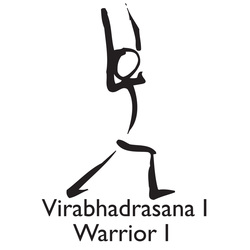In a word, yes. Yoga is a peaceful practice. However, the world around us and circumstances we find ourselves in are often less that peaceful. So our inner warriors are the resilient, courageous parts of ourselves that face adversity, turmoil and challenge with focus, kindness, and resolve.
Physical Cues: Warrior I can be practiced as part of a Sun Salutation flow or on its own. Here I will guide you through the pose from standing. Stand at the front of your mat with feet together and grounded solidly, spine upright, crown of the head lengthening upward with shoulders relaxed down. Take the left foot back about 3 feet or so, depending on your height. Turn the left toes forward as much as the ankle will allow, and square the hips forward toward the front of the mat by bringing the left hip forward and pressing the right hip back. (These are very subtle alignment cues that you will may feel more than actually see externally.) Align your front heel to back heel as best you can, or widen out the right foot to the right if this provides more allowance for the forward facing hip motion. Bend into the right knee up to 90 degrees, ensuring that the right knee doesn't go past the right ankle. As you bend the knee, you may feel significantly more of a stretch in the front of the hips, so just go as far as you can continue to breath calmly. For more intensity in this pose, take the stance wider by walking the back foot back, or for a less challenging posture, shorten the stance. Tuck the tailbone under you by engaging the abdominal muscles and pressing the navel towards the spine. Let the arms and chest rise up from this strong, grounded pelvis. The arms can be overhead, palms facing each other, or hands can rest on the hips. When you've held the pose for a few deep breaths, step up and switch legs, now practicing with the left leg forward. Mental Benefits: Warrior 1 can be a challenging standing posture. There is alot going on in this pose! Feet are strongly grounded, legs are cultivating strength, hips are gaining flexibility, arms and chest are alive but relaxed, and core is fully engaged. Much like our daily lives, this pose offers a slew of sensations competing for our attention. To pay attention closely to one sensation is to allow our focus to shift from another, and so on. Shifting attention fully from one thing to another is the stuff of mindful "non-meditation" that we can use to be fully present in more moments than not, creating a sense of showing up in our own life. Warrior 1 also helps us get to know the unique structure of our own bodies. It can teach us to respect and explore the limits of our flexibility and endurance. We practice self-compassion as we modify the alignment of the hips and heels, and the wideness of the stance. We make these modifications in order to be kind to ourselves, and recognize exactly the state of our bodies in the present moment. And finally, Warrior 1 and many other standing poses offer a reflection of our inner emotional habits and cognitive self-talk. Because the poses can be physically challenging, we may find unpleasant emotions arising like anger, fear, or disappointment. Likewise, when we feel strong in the pose, emotions like joy and contentment may arise. We may hear negative self-talk, or automatic tapes, playing in our head, like "I'm not strong enough," or "I'm not flexible enough." Or we might hear ourselves making judgments like "last week I was so much stronger in this pose," or "this pose used to be challenging, but now I'm bored with it." As we observe our emotional and cognitive habits in yoga, we learn more about how these habits manifest in our lives off the mat. Learn more about yoga therapy at Flourish here. Comments are closed.
|
AuthorKambria Kennedy-Dominguez, LPC-S |
Phone: 972.755.9120 | Fax: 214.723.5345
533 W. 12th Street Dallas, TX 75208
Privacy Policy Good Faith Estimate
©Flourish Counseling and Consultation PLLC 2024
533 W. 12th Street Dallas, TX 75208
Privacy Policy Good Faith Estimate
©Flourish Counseling and Consultation PLLC 2024


 RSS Feed
RSS Feed
